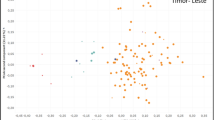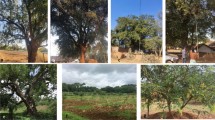Abstract
Background
In Tunisia, Kermes oak (Quercus coccifera L.) populations are severely destroyed due to deforestation. Nowadays, no preservation programs are attempted, yet, to conserve and promote the potential value of this resource. In this work, we assessed the genetic diversity of seven natural Tunisian populations of Q. coccifera from different bioclimates using Inter-Simple Sequence Repeats molecular markers. The distribution of the genetic diversity of Q. coccifera constitutes the pioneer step in the process of the conservation of the species.
Methods and Results
Nine selected ISSR markers were analyzed to characterize the genetic profiles of 70 different genotypes. The ISSR primers produced 64 loci ranging from 6 (UBC809 and UBC810) to 9 (UBC873) with an average of 7.11 at the species level. The average percentage of the polymorphic loci varied from 64.06% (Tabarka) to 76.56% (El Haouaria). The analyzed genotypes (70 individuals) revealed a high level of genetic diversity at species level (Na = 1.697; Ne = 1.517; He = 0.289; I = 0.418). The major proportion of the variation was attributable to individual differences within populations (76.07%). Analysis of molecular variance revealed also significant differentiation among all populations (ΦST = 0.245) and among populations within bioclimates (ΦSC = 0.233), even at a low scale space. The UPGMA and the PCoA analyses showed that most populations clustered independently to bioclimate or geographical distance indicating that genetic differentiation mainly occurs at local space scale due to genetic drift.
Conclusions
The in-situ conservation of the species should be maintained on natural populations as a forest genetic resources. Moreover, ex-situ conservation should involve the selection of genotypes with extensive collection of seeds and cuttings from different populations of the target area.


Similar content being viewed by others
Change history
02 July 2022
A Correction to this paper has been published: https://doi.org/10.1007/s11033-022-07589-6
References
Belahbib N, Ouassou A, Dahmani J, Douira A (2004) Contribution à l’étude de l’introgression génétique entre Quercus suber L. et Q. rotundifolia (Lamk.) Trabut au Maroc par l’utilisation des marqueurs microsatellites. Bulletin de l’institut scientifique, Rabat, Sect Sci de la vie, 26: 31–34
Hasnaoui B (1992) Chênaies du nord de la Tunisie: écologie et régénération. Thèse de doctorat en Sciences naturelles. Université De Provence-Aix-Marseille I, p 202
Belahbib N, Pemonge MH, Ouassou A, Sbay H, Kremer A, Petit RJ (2001) Frequent cytoplasmic exchanges between oak species that are not closely related: Quercus suber and Q. ilex in Morocco. Mol Ecol 10:2003–2012
Mhamdi S, Brendel O, Montpied P, Ghouil-Amimi H, Hasnaoui I, Dreyer E (2013) Leaf morphology displays no detectable spatial organization in the relict Quercus afares Pomel compared to the co-occurring parental species Q. canariensis Willd. and Q. suber L. Ann For Sci 70:675–684
Ortego J, Bonal R (2010) Natural hybridization between kermes (Quercus coccifera L.) and holm oaks (Q. ilex L.) revealed by microsatellite markers. Plant Biol 12:234–238
Toumi L, Lumaret R (2010) Genetic variation and evolutionary history of holly oak: a circum-Mediterranean species-complex [Quercus coccifera L./Q. calliprinos (Webb) Holmboe, Fagaceae]. Plant Sys Evol 290:159–171
Laakili A, Belkadi B, Medraoui L, Alami M, Yatrib C, Pakhrou O, Makhloufi M, El Antry S, Laamarti A, Filali-Maltouf A (2018) Diversity and spatial genetic structure of natural Moroccan Quercus suber L. assessed by ISSR markers for conservation. Physiol Mol Biol Plants 24:643–654
Sakka H, Baraket G, Abdessemad A, Tounsi K, Ksontini M, Salhhi-Hannachi A (2015) Molecular phylogeny and genetic diversity of Tunisian Quercus species using chloroplast DNA CAPS markers. Biochem Syst Ecol 11:1157–1164
Arbez M, Lacaze JF (1998) Station de Recherches Forestières. Bureau Des Ressources Génétiques. Les ressources génétiques forestières en France 2. INRA Editions, Paris, pp 2–12
Nabli MA (1995) Essai de synthèse sur la végétation et la phyto-écologie tunisiennes II et III. Le milieu physique et la végétation. Ecologie végétale appliquée
Ben ElHadj Ali I, Guetat A, Boussaid M (2011) Genetic diversity and structure of wild Tunisian Thymus capitatus (L.) Hoffm. et Link. (Lamiaceae) assessed using isozyme markers. Afr J Ecol 50:140–151
Medrano M, Herrera CM (2008) Geographical structuring of genetic diversity across the whole distribution range of Narcissus longispathus, a habitat-specialist, Mediterranean Narrow Endemic. Ann Bot 102:183–194
Ellstrand NC, Elam DR (1993) Population genetic consequences of small population size: implications for plant conservation. Annual Rev Ecol Syst 24:217–242
Rhimi A, Mnasri S, Ben Ayed R, Ben ElHadj Ali I, Hjaoujia S, Boussaid M (2019) Genetic relationships among subspecies of Capparis spinosa L. from Tunisia by using ISSR markers. Mol Biol Rep 46:2209–2219
Trieu LN, Mien NT, Tien TV, Ket NV (2016) Genetic diversity of Panax stipuleanatus Tsai in North Vietnam detected by inter simple sequence repeat (ISSR) markers. Biot Biotechnol Equip 30:506–511
Younsi F, Rahali N, Mehdi S, Boussaid M, Messaoud C (2018) Relationship between chemotypic and genetic diversity of natural populations of Artemisia herba-alba Asso growing wild in Tunisia. Phytochemistry 148:48–56
Zietkiewicz E, Rafalski A, Labuda D (1994) Genome fingerprinting by simple sequence repeat (SSR)-anchored polymerase chain reaction amplification. Genomics 20:176–183
Ansari SA, Narayanan C, Wali SA et al (2012) ISSR markers for analysis of molecular diversity and genetic structure of Indian teak (Tectona grandis Lf) populations. Ann For Res 55:11–23
Labra M, Grassi F, Sgorbati S, Ferrari C (2006) Distribution of genetic variability in southern populations of Scots pine (Pinus sylvestris L.) from the Alps to the Apennines. Flora Morphol Distrib Funct Ecol Plants 201:468–476
Pakhrou O, Medraoui L, Yatrib C, Alami M, Filali-maltouf A, Belkadi B (2017) Assessment of genetic diversity and population structure of an endemic Moroccan tree (Argania spinosa L.) based in IRAP and ISSR markers and implications for conservation. Physiol Mol Biol 23:651–661
Patel DM, Fougat RS, Sakure AA et al (2016) Detection of genetic variation in sandalwood using various DNA markers. Biotech 6:1–11
Emberger L (1966) Une classification biogéographique des climats. Recherches et Travaux des Laboratoires de Géologie, Botanique et Zoologie. Faculté des Sciences Montpellier 7:1–43
Doyle JJ, Doyle JL (1987) A rapid DNA isolation procedure for small quantities of fresh leaf tissue. Phytochemistry 19:11–15
Roldan-Ruiz I, Dendauw J, Bockstaele EV, Depicker A, Loose MD (2000) AFLP markers reveal high polymorphic rates in ryegrasses (Lolium spp.). Mol Breed 6:125–134
Powell W, Morgante M, Andre C, Hanafey M, Vogel J, Tingey S, Rafalski A (1996) The comparison of RFLP, RAPD, AFLP and SSR (microsatellite) markers for germplasm analysis. Mol Breed 2:225–238
Nei M (1973) Analysis of gene diversity in subdivided populations. Proc Natl Acad Sci USA 70:3321–3323
Yeh F, Yang R, Boyle T (1999) Popgene, Version 1.31. Microsoft Window-Based Freeware for Population Genetic Analysis. University of Alberta, Edmonton
Saitou N, Nei M (1987) The neighbour-joining method: a new method for reconstructing phylogenetic trees. Mol Biol Evol 4:406–425
Tamura K, Stecher G, Peterson D, Filipski A, Kumar S (2013) MEGA6: Molecular evolutionary genetics analysis version 6. Mol Biol Evol 30:2725–2729
Hampl V, Pavlcek A, Flegr J (2001) Construction and bootstrap analysis of DNA? ngerprinting-based phylogenetic trees with the freeware program FreeTree: application to trichomonad parasites. Int J Syst Evol Microb 51:731–735
Nei M, Li WH (1979) Mathematical model for studying genetic variation in terms of restriction endonucleases. Proceeding of the national academy of sciences of the USA 76: 5269–5273
Kovach WL (1999) MVSP-A Multi Variante Statistical Package for Windows, version 3.1. Kovach Computing Services, Pentraeth, Wales, UK
Excoffier L, Smouse PE, Quattro JM (1992) Analysis of molecular variance inferred from metric distances among DNA haplotypes: application to human mitochondrial DNA restriction data. Genetics 131:479–491
Lynch MB, Milligan G (1994) Analysis of population genetic structure with RAPD markers. Mol Ecol 3:91–99
Mantel N (1967) The detection of disease clustering and a generalized regression approach. Cancer Res 27:209–220
Raina SN, Rani V, Kojima T, Ogihara Y, Singh KP, Devarumath RM (2001) RAPD and ISSR fingerprints as useful genetic markers for analysis of genetic diversity, varietal identification, and phylogenetic relationships in peanut (Arachis hypogaea) cultivars and wild species. Genome 44:763–772
Lopez-Aljorna A, Bueno MA, Aguinagalde I, Martin JP (2007) Fingerprinting and genetic variability in cork oak (Quercus suber L.) elite trees using ISSR and SSR markers. Ann Folynchrest Sci 64:773–777
Ben ElHadj Ali I, Guetat A, Boussaid M (2012) Genetic diversity of North African Thymus algeriensis in Tunisia: Population structure and implication for conservation. Dendrobiology 67:67–77
Degen B, Yanbaev Y, Ianbaev R, Bakhtina S, Sultanova R (2021) When does habitat fragmentation lead to changes in populations gene pool of pedunculate oak (Quercus robur L.)? For Ecol Manage 499:119617
Singh A, Samant SS, Naithanit S (2021) Population ecology and habitat suitability modelling of Quercus semecarpifolia Sm. in the sub-alpine ecosystem of Great Himalayan National Park, north-western Himalaya, India. South Afr J Bot 141:158–170
Sampaio T, Gonçalves E, Faria C, Almeida MH (2021) Genetic variation among and within Quercus suber L. populations in survival, growth, vigor and plant architecture traits. For Ecol Manage 483:118715
Nybom H (2004) Comparison of different nuclear DNA markers for estimating intraspecific genetic diversity in plant. Mole Ecol 13:1143–1155
Audigeos D, Brousseau L, Traissac S et al (2013) Molecular divergence in tropical tree populations occupying environmental mosaics. J Evol Biol 26:529–544
Hamrick J, Murawski D, Nason J (1993) The influence of seed dispersal mechanisms on the genetic structure of tropical tree populations. In: Fleming T, Estrada A (eds) Frugivory and seed dispersal: ecological and evolutionary aspects. Kluwer academic publishers: Belgium 281–297
Takrouni MM, Boussaid M (2010) Genetic diversity and population’s structure in Tunisian strawberry tree (Arbutus unedo L.). Scientia Hortic 126:330–337
Coart E, Lamote V, De Loose M, Van Bockstaele E, Lootens P, Rpldan-Ruiz L (2002) AFLP markers demonstrate local genetic differentiation between two indigenous oak species [Quercus robur L. and Quercus petraea (Matt.) Liebl.] in Flemish populations. Theo Applied Genetics 105: 431–439
Coelho AC, Lima MB, Neves D, Cravador A (2006) Genetic diversity of two evergreen Oaks [Quercus suber (L) and Quercus ilex subsp rotundifolia (Lam)] in Portugal using AFLP markers. Silvae Genetica 55:105–118
Meena B, Singh N, Mahar KS, Sharma YK, Tikam SR (2019) Molecular analysis of genetic diversity and population genetic structure in Ephedra foliata: an endemic and threatened plant species of arid and semi-arid regions of India. Physiol Mol Biol Plants 25:753–764
Fischer M, Husi R, Prati D, Peintinger M, Van Kleunen M, Schmid B (2000) RAPD variation among and within small and large populations of the rare clonal plant Ranunculus reptans (Ranunculaceae). Am J Bot 87:1128–1137
Opdam P, Wascher D (2004) Climate change meets habitat fragmentation: linking landscape and biogeographical scale levels in research and conservation. Biol Cons 117:285–297
Acknowledgements
This research was supported by a grant of the Ministry of Scientific Research and Technology and the National Institute of Applied Science and Technology (Research grant UR 17ES22). We wish to express our thanks to the Laboratory of Plant Biotechnology, National Gene Bank of Tunisia (NGBT).
Author information
Authors and Affiliations
Corresponding author
Additional information
Publisher’s note
Springer Nature remains neutral with regard to jurisdictional claims in published maps and institutional affiliations.
Electronic supplementary material
Below is the link to the electronic supplementary material.
Rights and permissions
About this article
Cite this article
Flihi, J., Rhimi, A., Yangui, I. et al. Genetic diversity and population structure of Tunisian wild Kermes oak (Quercus coccifera L.): Assessment by ISSR molecular markers and implication for conservation. Mol Biol Rep 49, 6215–6224 (2022). https://doi.org/10.1007/s11033-022-07417-x
Received:
Revised:
Accepted:
Published:
Issue Date:
DOI: https://doi.org/10.1007/s11033-022-07417-x




